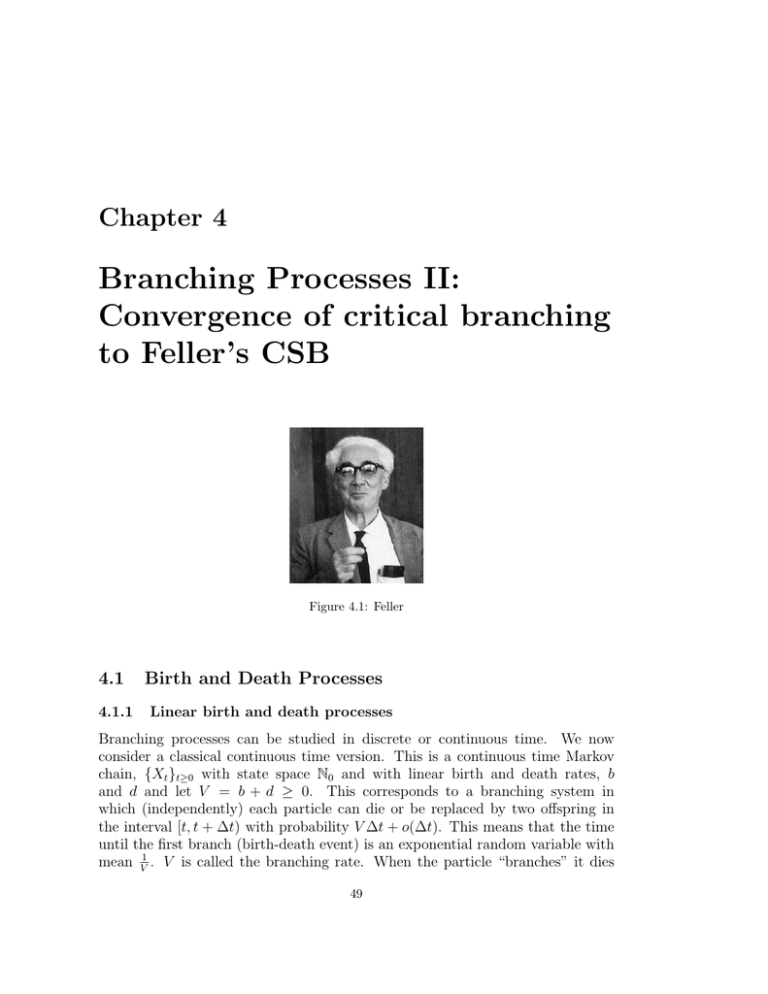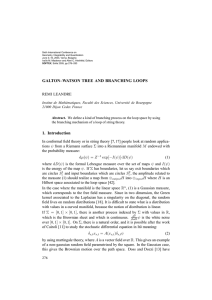Branching Processes II: Convergence of critical branching to Feller’s CSB Chapter 4
advertisement

Chapter 4
Branching Processes II:
Convergence of critical branching
to Feller’s CSB
Figure 4.1: Feller
4.1
4.1.1
Birth and Death Processes
Linear birth and death processes
Branching processes can be studied in discrete or continuous time. We now
consider a classical continuous time version. This is a continuous time Markov
chain, {Xt }t≥0 with state space N0 and with linear birth and death rates, b
and d and let V = b + d ≥ 0. This corresponds to a branching system in
which (independently) each particle can die or be replaced by two offspring in
the interval [t, t + ∆t) with probability V ∆t + o(∆t). This means that the time
until the first branch (birth-death event) is an exponential random variable with
mean V1 . V is called the branching rate. When the particle “branches” it dies
49
50
CHAPTER 4. BRANCHING PROCESSES II
d
b
with probability b+d
and is replaced by two descendants with probability b+d
.
Note that this process can be built directly on a probability space containing a
b
sequence of iid exponential (1) rv’s and a sequence of iid Bernoulli (p = b+d
)
rv’s (or a sequence of iid Uniform [0, 1] rv’s) and this description can be used to
generate a simulation of the model. The special case in which d = 0 is called the
Yule process.
The birth and death process can also be realized on a probability space (Ω, F, P )
on which independent Poisson random measures N1 , N2 on R2+ are defined. Then
the birth and death process is defined via a stochastic differential equation driven
by the Poisson noises, namely,
(4.1)
Z tZ
bX(s− )
Z tZ
dX(s−)
N1 (du, ds) −
X t = x0 +
0
0
N2 (du, ds).
0
0
This equation has a pathwise unique càdlàg solution which is a continuous time
Markov chain with the required transition rates. See Li-Ma [430].
Let Px0 denote the resulting probability law on DN0 ([0, ∞)), the space of càdlàg
functions from [0, ∞) to N0 .
4.1.2
Semigroups and generating functions
Given the Markov process Xt we can associate a Markov semigroup {Tt : t ≥ 0}
of operators on the Banach space C0 (N0 ) (the space of bounded functions on N0 ,
with limits at infinity) as follows:
Z
Tt f (x0 ) := Ex0 (f (Xt )) = f (x)Px0 (Xt ∈ dx).
This semigroup determines the finite dimensional distributions of the Markov
chain. This semigroup satisfies the conditions of the Hille-Yosida theorem with
generator given by
dTt f (n)
|t=0
dt
= bn(f (n + 1) − f (n)) + dn(f (n − 1) − f (n))
Gf (n) =
Now consider the Laplace function of Xt starting with one particle at time 0:
L(t, θ) := Ex0 (e−θXt ), with x0 = 1, θ ≥ 0
Noting the outcome at the first branching time and using the independence of the
particle and its offspring when a birth occurs, we obtain the nonlinear renewaltype equation
Z t
d
b
−V t
−V t −θ
L(t, θ) = e e +
(1 − e ) + V
e−V u L2 (t − u, θ)du
b+d
b+d 0
4.1. BIRTH AND DEATH PROCESSES
51
Alternately, note that we can represent the jump in Xt at a branching time
by the addition of an independent random variable ζ with Laplace transform
b
d θ
E(e−θζ ) = b+d
e−θ + b+d
e . Since the branching occurs at linear rate V Xt at time
t, we get
L(t + ∆, θ) − L(t, θ)
∂L(t, θ)
= lim
∆→0
∂t
∆
−θXt+∆
E(E(e
|Xt− )) − E(e−θXt− )
= lim
∆→0
∆
−θ(Xt− +ζ)
V ∆[E(Xt− E(e
|Xt− )) − E(Xt− e−θXt− )] + o(∆)
= lim
∆→0
∆
b
d
∂L(t, θ)
= −{V
(e−θ − 1) + V
(eθ − 1)}
.
b+d
b+d
∂θ
. So we then have the first order PDE
Here we have used E(Xe−θX ) = − ∂L(θ)
∂θ
(4.2)
∂L(t, θ)
b
d
∂L(t, θ)
+V[
(e−θ − 1) +
(eθ − 1)]
= 0,
∂t
b+d
b+d
∂θ
L(0, θ) = e−θ .
We can solve this by finding the characteristic curves (t(s), θ(s)) in the (t, θ)
plane along which L(t(s), θ(s)) is constant (refer to Garabedian (1964) [258], John
(1982) [350] or Delgado (1997) [157]). We write this as
(4.3)
∂
∂t(s)
∂θ(s)
L(t(s), θ(s)) = L1
+ L2
=0
∂s
∂s
∂s
where L1 , L2 denote the first partial derivatives with respect to t, θ respectively.
Comparing (4.3) with (4.2) leads to the characteristic equations
(4.4)
∂L(s)
= 0,
∂s
∂t(s)
= 1,
∂s
∂θ(s)
= h(θ) = b(e−θ − 1) + d(eθ − 1)
∂s
For b 6= d we obtain the characteristic curve
(4.5)
(e−θ − 1)e(b−d)t
= constant.
be−θ − d
and general solution
(4.6) L(t, θ) = Ψ(
(e−θ − 1)e(b−d)t
)
be−θ − d
where Ψ is a differentiable function. From the initial condition we have
(4.7) Ψ(
e−θ − 1
) = e−θX0 .
be−θ − d
52
CHAPTER 4. BRANCHING PROCESSES II
Solving for Ψ we obtain for b 6= d the solution
−θ
X0
d(e − 1)e(b−d)t − (be−θ − d)
(4.8) L(t, θ) =
b(e−θ − 1)e(b−d)t − (be−θ − d)
and for b = d
(4.9) L(t, θ) =
1 − (bt − 1)(e−θ − 1)
1 − bt(e−θ − 1)
X0
.
Remark 4.1 Note that the form of the Laplace transforms (4.8), (4.9)implies
the branching property, namely, if X0 = X0,1 + X0,2 , then the probability law
of Xt is identical to the distribution of the sum of independent random variables
Xt,1 + Xt,2 where Xt,i are versions of the linear birth and death process with initial
conditions X0,1 , X0,2 .
Distribution function, moments, extinction probability
Setting b, d as the birth and death rates. Then replacing θ by − ln z in Lt (θ) we
obtain the probability generating function
(4.10) Gt (z) = L(t, − ln z) =
∞
X
z k pk (t).
k=0
Then expanding in a power series in z we can obtain the standard formula
(4.11) p0 (t) = f (t),
(4.12) pn (t) = (1 − f (t))(1 − g(t))g(t)n−1 , n ≥ 1
where
(4.13) f (t) =
d(e(b−d)t − 1)
,
be(b−d)t − d
Similarly if b = d =
(4.14) pn (t) =
V
2
g(t) =
b(e(b−d)t − 1)
.
be(b−d)t − d
, then
(bt)n−1
, n ≥ 1,
(1 + bt)n+1
bt
.
1 + bt
Then the extinction probability is
(4.15) p0 (t) =
1 if b ≤ d,
d(e
− 1)
= d
(4.16) lim p0 (t) = lim
t→∞
t→∞ be(b−d)t − d
if b > d.
b
(b−d)t
4.2. CRITICAL BRANCHING
53
Recalling that
∂Lt (θ) (4.17) E(Xt ) = −
,
dθ θ=0
∂ 2 Lt (θ) (4.18) E((Xt ) ) =
.
dθ2 θ=0
2
we can obtain
(4.19) E(Xt ) = X0 e(b−d)t ,
(4.20) E((Xt )2 ) = (X0 )2 e2(b−d)t +
X0 (b + d) (b−d)t (b−d)t
e
(e
− 1), b 6= d
b−d
(4.21) E((Xt )2 ) = (X0 )2 + 2bt, if b = d.
4.2
Critical branching
Exponential growth of a population is unrealistic and therefore supercritical
branching models describe only the growth of a population as long as the resources are unlimited. Otherwise logistic competition comes into play. We will
return to this circle of questions throughout this course.
Only critical branching processes have the property that the mean population
size is stable but as shown above the critical branching process actually suffers
extinction with probability one. Nevertheless critical branching processes have
played a key role in the development stochastic population models. We will later
see that a key feature of critical branching is the limiting behavior of the process
conditioned on non-extinction up to time t and letting t → ∞. We now give two
formulations of the resulting behavior.
Theorem 4.2 Consider the BGW process Zn with mean offspring size m = 1.
Suppose that σ 2 := Var(ξ) = E[ξ 2 ] − 1 ≤ ∞. Then
(i) Kolmogorov
(4.22) lim nP [Zn > 0] =
n→∞
2
σ2
(ii) Yaglom: If σ < ∞, then the conditional distribution of
2
converges as n → ∞ to an exponential law with mean σ2 .
We refer the proof of this to the literature [9], [438].
Zn
n
given Zn > 0
54
CHAPTER 4. BRANCHING PROCESSES II
Theorem 4.3 Consider the critical linear birth and death process, {Xt } with
α = 21 , b = d = V2 . Then
(i) Extinction probability: limt→∞ p0 (t) = 1.
(ii) Expected extinction time: Let τ := inf{t : Xt = 0} Then E[τ ] = ∞.
(iii) Exponential limit law: conditioned on Xt 6= 0,
Xt
⇒Y
t
where Y is exponential with mean b.
Proof. The proof is based on the explicit form of the generating function
(4.9).
bt
→ 1 as t → ∞.
(i) From (4.15), p0 (t) = bt+1
(ii) The expected extinction time is infinite
Z ∞
Z ∞
1
dt = ∞.
E(τ ) =
(1 − p0 (t))dt =
bt + 1
0
0
(iii) From (4.9),
(4.23)
E(e
=
−
Xt θ
t
L(t, θt ) − P (Xt = 0)
|Xt =
6 0) =
1 − P (Xt = 0)
1−(bt−1)(e−θ −1)
1−bt(e−θ−1 )
1
bt+1
lim E(e−
t→∞
Xt θ
t
−
bt
bt+1
|Xt 6= 0) =
1
1 + bθ
and which is the Laplace transform of the exponential distribution with mean b.
4.3
Feller’s continuous state branching process (CSBP)
Consider the Itô stochastic differential equation (SDE)
p
dXt = mXt dt + γXt dWt , X0 = x ≥ 0
where {Wt } is a standard Brownian motion. This equation has a non-Lipschitz
coefficient but its pathwise uniqueness follows from the Yamada-Watanabe theorem [617].
4.3. FELLER’S CONTINUOUS STATE BRANCHING
55
Using Itô’s lemma one can then check that the generator of the resulting
diffusion process acting on D(G) = {f ∈ C02 (R+ ), xfx , xfxx ∈ C0 (Rd+ )} satisfies
∂f
1 ∂ 2f
+ γx 2
∂x 2 ∂x
and therefore Xt is a realization of the Feller CSBP process.
(4.24) Gf (x) = mx
Proposition 4.4 (Laplace transform and extinction probability)
(a)The Laplace transform is given by
(4.25) L(θ, t) = Ex exp(−θXt ) = exp(−u(t)x)
where u(s) satisfies the equation:
(4.26)
∂u
γ
= mu − u2
∂s
2
u(0) = θ.
(b) In the critical case m = 0
x
(4.27) Px (xt = 0) = exp −
.
γt
Proof. Assume that θ(s) ≥ 0 is differentiable. Then applying Itô’s lemma ([517],
Theorem 3.3, Remark 1) to F (θ, x) = e−θx we have
(4.28)
F (θ(t), Xt ) − F (θ(0), X0 )
Z t
Z t
p
=m
Xs F2 (θ(s), Xs )ds +
F2 (θ(s), Xs ) γXs dWs
Z t 0
Z0
γ t
+
F1 (θ(s), Xs )dθ(s) +
Xs F22 (θ(s), Xs )ds
2 0
0
Noting that E(Xs e−θXs ) = −L1 (θ, s) we obtain
(4.29)
∂L(θ(s), s)
dθ(s)
γ
= L1 (θ(s), s)
− mθ(s)L1 (θ(s), s) + θ(s)2 L1 (θ(s), s)
∂s
ds
2
−θx
with L(θ, 0) = e
If u is a solution of
∂u(θ, s)
γ
= mu(θ, s) − u2 (θ, s),
∂s
2
then the derivative with respect to s
(4.30)
∂
L(u(θ, t − s), s) = 0,
∂s
and therefore
u(θ, 0) = θ
0≤s≤t
(4.31) Ex (e−θXt ) = L(θ, t) = L(u(θ, t), 0) = e−u(θ,t)x .
56
CHAPTER 4. BRANCHING PROCESSES II
(b) Solving (4.30) we get
(4.32) u(θ, t) =
θ
, if m = 0
(1 + tγθ)
(4.33) u(θ, t) =
θmemt
, if m 6= 0.
m + γθ(emt − 1)
If m = 0
x0
(4.34) PX0 (xt = 0) = lim e−x0 u(θ,t) = e− γt .
θ→∞
Remark 4.5 An immediate consequence of (4.31) is that for each t, Xt is an infinitely divisible random variable. In fact the law of Xt corresponds to the law of
the sum of a Poisson distributed number of independent exponential random variables. These facts will provide an important tool for the study of these processes
and their infinite dimensional generalizations.
Feller CSBP with immigration
Adding an immigration term ct to Xt , one obtains the continuous state branching
with immigration process (CBI), and can verify (see e.g. Li (2006) [426]) the
following:
Proposition 4.6 Consider the continuous subcritical branching process with immigration (CBI), given by the SDE:
p
(4.35) dYt = cdt − bYt dt + γYt dWt , Y0 = y0 , b, c > 0.
(a) The Laplace transform of the distribution of Yt is given by:
∂u
γ
= −bu − u2 u(0) = θ > 0.
∂t
2
(b) In the subcritical case Yt converges to equilibrium, Yt ⇒ Y∞ as t → ∞,
where Y∞ has the gamma distribution with Laplace transform
c
(4.37) L(θ) =
.
[(b + γθ) − γθe−bt ]1/γ
Rt
(4.36) Ey0 exp(−θY (t)) = e−y0 u(t)−
0
cu(s) ds
;
Proof. (a) This can be proved using the method of Theorem 4.4. Alternately,
weP
can prove this by consider the process with immigrants coming according to
1
δyi where {yi } are the points of a Poisson process with rate K and letting
K
K → ∞.
(b) follows from (a) by simple integration of (4.36).
4.4. DIFFUSION PROCESS LIMITS
57
Remark 4.7 The critical Feller CSBP with immigration
dYt = βdt + 2
(4.38)
Y0 = y0
p
Yt dWt
is the square of a β-dimensional Bessel process. (See Revuz Yor [517] where this
is called a BESQβ process). For β ≥ 2, {0} is polar. For 0 < β < 2, {0} is
instantaneously reflecting. For 0 < β < 1 the set {t : Xt = 0} is a perfect set.
(See Revuz Yor [517] Chap. XI.)
4.4
4.4.1
Diffusion limits of critical and nearly critical branching processes
Convergence to Feller’s continuous state branching process
In a celebrated paper Feller (1951) [242] developed the diffusion approximation
to branching processes using semigroup methods.
Theorem 4.8 (Convergence of B+D and BGW processes to Feller CSBP)
(a) Consider the sequence of birth and death process, {XtK }, K ∈ N, with
m
m
linear birth and death rates bK = 1 + 2K
, dK = 1 − 2K
with X0K = bKzc. Assume
→ x and let
that bKzc
K
(4.39) ZtK :=
1 K
X .
K Kt
Then as K → ∞
(4.40) {ZtK }t≥0 =⇒ {Zt }t≥0 ,
where {Zt }t≥0 is a CSBP with generator G given by (4.24) with γ = 1 and Z0 = x.
The convergence is in the sense of weak convergence of probability measures on
D[0,∞) ([0, ∞)) and the limiting process is a.s. continuous.
(b) Consider a sequence of BGW processes {XkN } with mean offspring sizes
(4.41) E(ξ N ) = mN = 1 +
and offspring variances
(4.42) Var(ξ N ) = γ > 0.
Let
(4.43) ZtN :=
1 N
X
.
N bN tc
m
N
58
CHAPTER 4. BRANCHING PROCESSES II
Assume that Z0N → Z0 as N → ∞. Then
(4.44) {ZtN }t≥0 =⇒ {Zt }t≥0 ,
that is, ZtN converges in distribution on D[0,∞) ([0, ∞)) to a Markov diffusion
process, {Zt }t≥0 , called the Feller continuous state branching process (CSBP).
The generator of the CSBP {Zt } acting on functions f ∈ C02 ([0, ∞)) is given by
(4.45) Gf (x) = mx
∂f
1 ∂ 2f
+ γx 2 .
∂x 2 ∂x
Proof. (a) The proof follows a standard program for weak convergence of
processes, namely,
• the convergence of the finite dimensional distributions,
• proof that the laws of the processes P K ∈ P(D[0,∞) ([0, ∞)) are tight.
To show that the finite dimensional distributions converge, first substitute
m
m
birth and death rates b = 1 + 2K
, d = 1 − 2K
, in (??) to obtain the Laplace
K
K
transform of Zt with Z0 = bKzc as follows:
(4.46)
K
E(e−θZt ) = LK (t, θ)
θ
=
=
−
−
K(e− K − 1)(emt − 1) −
θ
K(e− K − 1)(emt − 1) +
θ
m −K
(e
2
θ
m −K
(e
2
− 1)emt −
− 1)emt −
θ
m −K
(e
2
θ
m −K
(e
2
+ 1)
!bKzc
+ 1)
θ
θ
θ2
− m2 (e− K − 1)emt − m2 (e− K + 1) + O(K −2 )
2K
θ
θ
θ2
+ m2 (e− K − 1)emt − m2 (e− K + 1) + O(K −2 )
+ 2K
mt
(−θ)(emt − 1) +
−θ(emt − 1)
mθze
−→ exp −
m + θ(emt − 1)
!bKzc
.
This coincides (see Proposition 4.4) with the Laplace transform at time t of the
diffusion process with Z0 = x and with generator
(4.47) Gf (x) = mx
∂f
1 ∂ 2f
+ x 2.
∂x 2 ∂x
Using the Markov property and the continuity of the transition probability in
x we can then obtain convergence of the finite dimensional distributions.
To complete the proof we must verify that the probability laws of {ZtK }t≥0
denoted by P K ∈ P(D[0,∞) ([0, ∞)) are tight. We will use the Aldous condition.
We first verify that given δ > 0 there exists 0 < L < ∞ such
(4.48) sup P K ( sup X K (t) > L) ≤ δ.
K
0≤t≤T
4.4. DIFFUSION PROCESS LIMITS
Note that the generator of ZtK =
59
K
XKt
K
is
(4.49)
GK f (
n
n+1
n−1
n
mn
n+1
n−1
n
) = ·K 2 [f (
)+f (
)−2f ( )]+
·K[f (
)−f (
)].
K
K
K
K
K
2K
K
K
Then
(4.50)
MtK
:=
ZtK
Z
t
−m
ZsK ds is a martingale.
0
By Gronwall’s inequality
(4.51) sup ZtK ≤ sup |MtK |emt .
0≤t≤T
0≤t≤T
Applying Doob’s maximal inequality to MtK
(4.52) P ( sup |MtK | ≥ R) ≤
0≤t≤T
E((MTK )2 )
.
R2
It remains to compute E((MTK )2 ). We have
Z T
Z
K 2
K 2
K K
(4.53) E((MT ) ) ≤ E(ZT ) ) + 2|m|
E(Zs ZT )ds +
0
0
T
Z
T
E(ZsK ZtK )dsdt.
0
Using (4.20) we can check that
(4.54) E[(ZtK )2 ] ≤ Z0K emt
(emt − 1)
+ (Z0K )2 e2mt .
m
A simple calculation then yields
(4.55) E((MTK )2 ) ≤ C(T, z)
where C(T, z) does not depend on K which proves (4.48).
We can then apply the Aldous sufficient condition for tightness, namely, given
stopping times τK ≤ T and δK ↓ 0 as K → ∞
(4.56) lim P K (|ZτKK +δK − ZτKK | > ε) = 0.
K→∞
First note that XτKK is tight so we can take a convergent subsequence. Then by
Skorohod’s representation we can put these on a common probability space so
that there is a.s. convergence. In this setting assume that XτKKnn → x. In now
suffices to prove that XτKKnn +δKn converges in distribtion to x. Then by the strong
60
CHAPTER 4. BRANCHING PROCESSES II
Markov property we have
(4.57)
−θ(ZτK
E(e
K +δK
)
K
− e−θZτK |ZτKK )
θ
=
−
K(e− K − 1)(emδK − 1) −
K(e
θ
−K
−
1)(emδK
− 1) +
θ
m −K
(e
2
θ
m −K
(e
2
− 1)emδK −
−
1)emδK
−
θ
m −K
(e
2
θ
m −K
(e
2
+ 1)
!bKZτK
K
+ 1)
c
−→ 0 on { sup Z K (t) ≤ L} as K → ∞.
0≤t≤T
Therefore ZτKK +δK − ZτKK → 0 in distribution and for ε, η > 0 we can find K0 such
that
(4.58) P K (|ZτKK +δK − ZτKK | > ε) < 2η,
∀ K ≥ K0 .
This completes the proof of tightness.
(b) See Ethier and Kurtz ([222] Chapter 9, Theorem 1.3) for a proof based
on a semigroup convergence theorem (e.g. [222], Chap. 1, Theorem 6.5). This
involves showing that
(4.59) lim
N →∞
sup
`
x= N
|N (TN f (x) − f (x)) − Gf (x)| = 0 ∀ f ∈ Cc∞ ([0, ∞)),
, `∈N
where
Nx
1 X N
ξ )],
(4.60) TN f (x) = E[f (
N k=1 k
x∈{
`
, ` ∈ N}
N
and where {ξkN } are i.i.d. satisfy (4.41), (4.42).
Remark 4.9 These results can also be proved using the martingale problem formulation in the same way as is carried out below for the Wright-Fisher model.
4.5
4.5.1
The critical BGW tree
The rooted BGW tree as a metric space
We begin by recalling that given a BGW tree T ∈ T with root ∅ we can embed
it in the plane the edges appear according to the lexicographic order to produce a
plane tree. This is given by a subset of the set of potential individuals I satisfying
(3.1.2) and in which each parent is connected to its offspring by an edge. If we
assign length 1 to each edge then a metric d(x, y) can be defined on T by
(4.61) d(x, y) := the length of the shortest path in T from x to y.
K
− e−θZτK





![Branching Out: An Introduction to Family History [pptx , 2.3 MB]](http://s2.studylib.net/store/data/005232376_1-8bb1ea3bff509441ce8b545117622545-300x300.png)